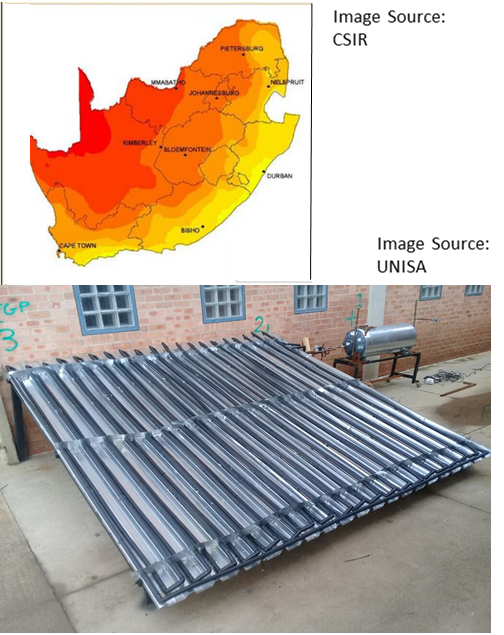Development of a large-area, low-cost solar water-heating system for South Africa with a high thermal energy collection capacity
DOI:
https://doi.org/10.17159/2413-3051/2019/v30i1a5226Keywords:
solar energy, collection, heat transfer, automationAbstract
A low-cost heat-exchanger system that can be used in high-pressure/low-pressure isolated solar water-heating systems in South Africa was developed for household applications. The combination of a copper coil and electrical heater allowed for isolation of the high-pressure and low-pressure sections of the system and enabled the utilisation of large low-cost solar heat-absorber platforms that operated at low pressure with a low risk of fouling and leaking. The design comprised a copper coil heat exchanger to be installed inside a conventional geyser, to replace the normal heating element and thermostat system in a conventional commercially available household geyser. The electric heating element still supplements the system in low solar energy conditions. The circulation in the system is created by a small separate photovoltaic panel and a circulation pump. An integrated switch allows the system to alternate between conventional electrical heating and solar water-heating according to prevailing weather conditions. Current tests show that the system of 15 m2 area can be installed at a cost of approximately ZAR 10 000–12 000. The system can provide hot water at approximately 12 cents per kWh, with a total heat storage capacity of up to 10 kWh per day. This implies a saving to the customer of up to ZAR 600 per month. The accumulated saving to a household over the ten-year lifetime of the product is estimated at ZAR 200 000. As the thermal energy storage capacity of current systems as available on the local market is approximately 1 kWhr per day for a 2 m2 collector. A typical increase in thermal energy collection capacity of tenfold more than the capability of conventional systems on the market is hence achieved. The system offers implementation possibilities for South Africa’s low-cost housing schemes and can provide for creating numerous new business and job opportunities on the African continent with its abundant solar irradiation resources.
Downloads
References
Christophe, W & André, M. 2016. Les échangeurs de chaleur. Encyclopédie de l’énergie: Article No. 55. Available at: https://bit.ly/2HMACLN (accessed on 1 August 2017).
Eskom Residential Appliance Calculator. 2018. Availa-ble at: http://eskom-idm-residential-tools-webapp.fogg.za.com/web/#/ (accessed on 1 August 2017.
Lienhard, John IV, and Lienhard John V., 2011. A heat transfer textbook. 4th edition. Cambridge: Cam-bridge University Press:49.
One Energy Company. 2018. Available at: http://www.oneenergy.co.za/products.asp?P_ID=150&type=2 (accessed on 1 August 2017)
Price Check Company SA, 2018, available at: https://www.pricecheck.co.za/search?search=solar+geyser (accessed on 1 August 2017).
Saha, S.K., Tiwari, M., Sundén, B., Wu, Z. 2016. Ad-vances in heat transfer enhancement. Basel: Springer International:4.
Schreyer, CDR., 2011. Simulation of energy use in resi-dential water heating systems. Master of Applied Sci-ence thesis, Department of Mechanical Engineering, University of Victoria:7.
Cengel. Y.A., 2016. Heat Transfer: Practical Approach. 2nd edition.Amazon.com:17-18.
Snyman, LW., 2008. Smart controller for a household solar energy backup system. RSA Patent Journal, Patent 2008/567745 of May 2008. Granted: SA (2009/3071).
Snyman, LW., 2012. High pressure low pressure ther-mal energy collection system. RSA Patent Journal, Patent 2012/1508.
Snyman, LW. 2016. Integrated roof solar thermal energy collector. RSA Patent Journal, Patent SA 2016/05297.
Tobaly, P. 2002. Échangeurs de chaleur. Licence profes-sionnelle thesis, IUT of St Denis, GPI:10–11.

Downloads
Published
Issue
Section
License
Copyright (c) 2019 Monga F. Twite, Lukas W. Snyman, Johan De Koker, Dayo Yusuff

This work is licensed under a Creative Commons Attribution-ShareAlike 4.0 International License.



.png)